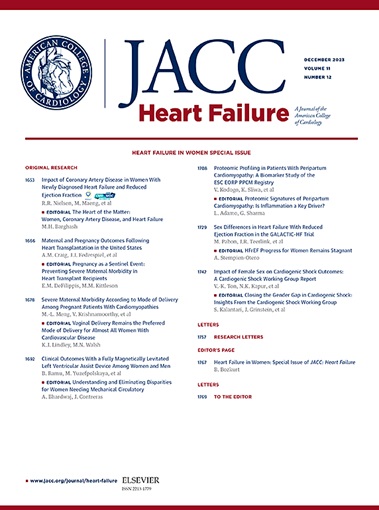脑死亡后左室局部壁运动异常模式及其临床意义
IF 10.3
1区 医学
Q1 CARDIAC & CARDIOVASCULAR SYSTEMS
引用次数: 0
摘要
背景:在脑死亡后的潜在心脏供者中,左心室功能障碍很常见,但这一人群中特定的区域壁运动异常(RWMA)模式尚未得到很好的描述。目的本研究旨在通过机器学习算法定义和表征脑死亡后潜在心脏供者的RWMA模式。供体心脏研究招募了4333名脑死亡后的潜在心脏供体。所有患者均行经胸超声心动图(TTE),包括RWMA评估,并对每个节段进行WMS(壁运动评分)分析。使用k-means聚类对任何RWMA(即任何WMS >;1)的患者进行分类,并评估每个聚类与供体临床特征、心脏使用和受体生存的关联。结果最终的分析队列包括913例初始样本。我们确定了4种独特的RWMA表型:局灶性基底室间隔(FBS) (n = 500),基底和中室间隔(n = 311),根尖(n = 66)和整体低运动(n = 36)。这些表型表现出相似的供体特征,但在肌钙蛋白、n端前b型利钠肽水平(FBS最低)和左心室射血分数(LVEF) (FBS最高)方面存在差异。在随后的试验中(在314名任何RWMA的供者中进行),所有表型的LVEF都有显著改善。FBS表型的供体心脏移植接受度最高(68%)。在接受移植的心脏中,RWMA表型在受体存活率方面没有显著差异。结论脑死亡后的左心室功能障碍表现出不同的RWMA表型,在选择的生物标志物和LVEF方面存在差异,但在接受移植的心脏的受体存活方面没有差异。本文章由计算机程序翻译,如有差异,请以英文原文为准。
Patterns of Left Ventricular Regional Wall Motion Abnormalities After Brain Death and Their Clinical Significance
Background
Left ventricular dysfunction is common in potential heart donors after brain death, but specific regional wall motion abnormality (RWMA) patterns in this population have not been well described.
Objectives
This study aims to define and characterize RWMA patterns in potential heart donors after brain death by using a machine learning algorithm.
Methods
The Donor Heart Study enrolled 4,333 potential heart donors after brain death. All had a transthoracic echocardiogram (TTE) including RWMA assessment, with each segment analyzed for WMS (Wall Motion Score). Those with any RWMA (ie, any WMS >1) were classified using k-means clustering, and each cluster’s associations with donor clinical characteristics, heart use, and recipient survival were assessed.
Results
The final analytical cohort included 913 initial TTEs. We identified 4 unique RWMA phenotypes: focal basal septal (FBS) (n = 500), basal and midventricular (n = 311), apical (n = 66), and global hypokinesis (n = 36). These phenotypes exhibited similar donor characteristics but differed in troponin, N-terminal pro–B-type natriuretic peptide levels (both lowest in FBS), and left ventricular ejection fraction (LVEF) (highest in FBS). On subsequent TTEs (performed in 314 donors with any RWMA), all phenotypes demonstrated significant improvement in LVEF. The FBS phenotype had the highest donor heart acceptance for transplantation (68%). Of the hearts accepted for transplantation, there were no significant differences by RWMA phenotype in recipient survival.
Conclusions
Left ventricular dysfunction after brain death exhibits distinct RWMA phenotypes, which differ in terms of selected biomarkers and LVEF, but not in recipient survival of the hearts accepted for transplantation.
求助全文
通过发布文献求助,成功后即可免费获取论文全文。
去求助
来源期刊

JACC. Heart failure
CARDIAC & CARDIOVASCULAR SYSTEMS-
CiteScore
21.20
自引率
2.30%
发文量
164
期刊介绍:
JACC: Heart Failure publishes crucial findings on the pathophysiology, diagnosis, treatment, and care of heart failure patients. The goal is to enhance understanding through timely scientific communication on disease, clinical trials, outcomes, and therapeutic advances. The Journal fosters interdisciplinary connections with neuroscience, pulmonary medicine, nephrology, electrophysiology, and surgery related to heart failure. It also covers articles on pharmacogenetics, biomarkers, and metabolomics.
 求助内容:
求助内容: 应助结果提醒方式:
应助结果提醒方式:


